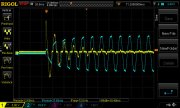After about 6 years of fooling around I finalized a circuit board with a triac to save the Arrow Hart power switch on the 700B's. I listed it on EBAY tonight. Then I searched for it to verify the listing. The first search result surprised me. Here's the link. 700B Power Switch The $90 price tag certainly caught my eye. It has a type D shaft and the original is round. However I can see no way it will fit. I wrote to the seller to ask if he verified it.
I attached a screenshot of the inrush current (yellow) on a 700B with 15,000uf caps. The first half cyce, at 50A/divison is almost 150 amps. Look at how the voltage (blue waveform) crashed. My house is less than 100 feet form the distribution transformer.
I attached a screenshot of the inrush current (yellow) on a 700B with 15,000uf caps. The first half cyce, at 50A/divison is almost 150 amps. Look at how the voltage (blue waveform) crashed. My house is less than 100 feet form the distribution transformer.
Attachments
-
84.8 KB Views: 22


